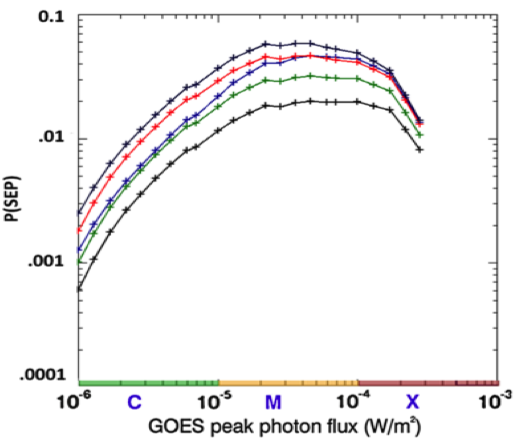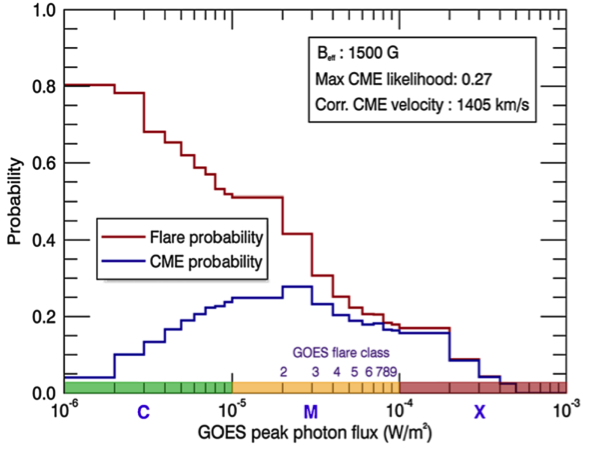A novel operational open-access forecasting system that provides reliable forecasting and nowcasting of solar energetic particle (SEP) events, as well as forecasting of solar flares (SFs) based on precursor information, is presented. FORSPEF offers continuous forecasts and nowcasts of SFs and SEP events, up to 70◦ E/W covering practically the entire course of an active-region (AR) toward the limb (up to ~85◦). The prediction window in the forecasting scheme is 24 hours with a refresh rate of 3 hours, while the respective prediction time for the nowcasting scheme depends on the availability of the near real-time data and ranges between 15 – 20 minutes for solar flares and 6 hours for CMEs. All outputs are available online at http://tromos.space.noa.gr/forspef/ and can be freely accessed and used by the scientific community. The activity that led to FORSPEF tool was supported through the European Space Agency (ESA).
The FORSPEF Tool:
The FORSPEF tool consists of three modules that aim to forecast i) the likelihood of upcoming solar flare eruptions, ii) the occurrence of SEPs by making a prediction of the time before onset, and iii) the SEP characteristics for an upcoming event, respectively. Additionally, FORSPEF incorporates two operational modes, the forecasting and the nowcasting modes. The former is understood as the pre-event mode, since no actual solar event (i.e. SF or CME) has yet taken place. The only available information is the identification of an AR on the Sun and its calculated Beff metric (see Georgoulis and Rust 2007). The latter corresponds to the post-event mode, in which a solar event has actually taken place and its characteristics (for solar flares the longitude and the magnitude, and for CMEs the width and the velocity) are available.
The solar flare forecasting module delivers conditional flare probabilities complemented by information on CME probabilities and expected CME speeds. The prediction of SFs relies on the effective connected magnetic field strength (Beff) metric, which is based on an assessment of potentially flaring AR magnetic configurations, and it uses a sophisticated statistical analysis of a large number of AR magnetograms. CME probabilities and projected speeds are based on the peer-reviewed published flare-to-CME association rates (Yashiro et al., 2005) and on the statistical correlation between Beff-values and recorded near-Sun CME velocities (Georgoulis, 2008), respectively.
For each identified solar AR, the output of the FORSPEF flare forecasting module is a structure containing the AR NOAA number, its location, the corresponding Beff value, the 24-hour cumulative flare probabilities for each of the 28 GOES flare classes (from C1.0 to X10.0) and their peak photon fluxes (PPFs), the respective eruptive-flare or CME likelihoods, and the projected CME velocity. The SF forecasting produces histogram curves of the cumulative flare probabilities and CME likelihoods versus the flare PPF. The cumulative forecast probabilities for flares (solid red histogram) and CME likelihood (solid blue histogram) for a sample AR are shown in Figure 1.

Figure 1: Pictorial output of the FORSPEF solar flare forecasting and likelihood of CME prediction scheme: shown are the 24-hour cumulative forecast probabilities for flares (solid red histogram) and CME likelihoods (solid blue histogram) for a sample AR (From Papaioannou et al. 2015).
For the prediction of SEP events, new statistical methods have been developed for the likelihood of the SEP occurrence and the expected SEP characteristics. These are based on a comprehensive database of SFs, CMEs and SEP events (Papaioannou et al., 2016). In the forecasting scheme, the FORSPEF tool provides the probability of SEP occurrence based on the information delivered by the solar flare forecasting. The kernel of SEP prediction is based on the probability of SEP occurrence per solar flare magnitude which is derived from a historical sample of 4000 flares. These probability values are used to implement a local SEP statistical model via distribution functions. The FORSPEF tool in this forecasting scheme provides a weighted forecast for the expected occurrence of an SEP event per AR, calculated as the product of the local SEP module and the cumulative SF probabilities. The output of the SEP forecasting scheme is the maximum probability for each of the considered ARs. The final product of the probability of SEP occurrence per longitudinal bin is shown in Figure 2.

Figure 2: The probability of SEP occurrence per longitudinal bin. This plot is the output of FORSPEF’s SEP forecasting. The FORSPEF tool provides the maximum SEP probability as defined by the respective folded curve per longitudinal bin.
Nowcasting FORSPEF’s scheme can be considered as the short-term forecasting that is triggered by a solar eruptive even. FORSPEF has developed two operational nowcasting modules –one that is based on near real-time solar flare information (longitude, magnitude) and another module that makes use of near-real time CME data (width, velocity). For the first operational module the inputs of the FORSPEF nowcasting work-scheme are in practice the outputs of the Solar Demon service (a service operated by the Royal Observatory of Belgium), in particular the maximum flare flux and its position (longitude) on the visible part of the solar disk. FORSPEF makes use of all ≥C1.0 flares spotted by this service. The detection of SEP events, in terms of the occurrence probability, is performed based on those actual near real-time solar flare data. For the second operational module the nowcasting scheme uses the near real-time outputs provided online through the computer-aided CME tracking software (CACtus), operated by ROB. Further details on this module are presented in the recent work of Papaioannou et al. (2017).
All components of the FORSPEF tool were validated based on archived data. As a first step, we validated the forecasting/nowcasting modules using an extensive statistical study on a significant large archived sample of solar flare, CME, radio flux, and SEP events. We constructed categorical scores for the predictions issued by the different modules, with the analysis performed on randomly selected training and trial samples. Furthermore, we included scatter plots of observed versus predicted SEP properties (characteristics) to quantify the capabilities of the tool. Additionally, as a second step, we investigated detailed case studies of significant SEP events that have previously been reported in the literature. Blind tests with archived parent solar data of these events were applied to the various modules of the FORSPEF tool in order to derive the probabilities of SEP detection per module and per event.
Discussion and Conclusions:
The basic implementations of the FORSPEF tool presented here are summarized as follows:
- To predict solar flares, FORSPEF incorporates a module that makes use of the effective connected magnetic field strength prediction metric (Beff). The corresponding statistics are based on an extended database of magnetograms that covers Solar Cycle 23.
- The prognosis of SEP events is based on a new database of SEP events and their parent solar events (i.e. SFs and CMEs). This comprehensive database covers an extended time span from 1984 – 2013, and brings together solar and particle observations coupling the events at the Sun to those detected at 1 AU.
- From an inferred flare probability for a single AR, we obtain a respective CME probability. On a region-per-region basis, we coupled this probability with CME velocity information and assessed the likelihood of CME shock formation thus.
- Furthermore, coupling the SF probability with a local distribution function obtained via the FORSPEF database of SEPs, solar flares, and CMEs, we assessed the likelihood of an SEP event in geospace 24hr in advance.
- Three modules were developed for short-term forecasting of SEP events and their corresponding characteristics, based on solar flare, CME, and radio flux data.
- All components of the FORSPEF tool were validated using an extensive statistical study on a significant large archived sample of solar flare, CME, radio flux, and SEP events.
Additional info:
The real-time results of FORSPEF are assessed in both textural and pictorial form through the web portal http://tromos.space.noa.gr/forspef/ .
Based on a recently published article:
Anastasiadis, A.; Papaioannou, A.; Sandberg, I.; Georgoulis, M.; Tziotziou, K.; Kouloumvakos, A.; Jiggens, P. (2017), “Predicting Flares and Solar Energetic Particle Events: The FORSPEF Tool” Solar Physics, 292 (9), article id. #134, 21 pp. DOI: 10.1007/s11207-017-1163-7
References:
Georgoulis, M.K.: 2008, Geophys. Res. Lett. 35, L06S02.
Georgoulis, M.K., Rust, D.M.: 2007, Astrophys. J. Lett. 661, 109.
Papaioannou, A., Anastasiadis, A., Sandberg, I., Georgoulis, M.K., Tsiropoula, G., Tziotziou, K., Jiggens, P., Hilgers, A.: 2015, J. Phys. Conf. Ser. 632(1), 012075.
Papaioannou, A., Sandberg, I., Anastasiadis, A., Kouloumvakos, A., Georgoulis, M.K., Tziotziou, K., Tsiropoula, G., Jiggens, P., Hilgers, A.: 2016, J. Space Weather Space Clim. 6(27), A42.
Papaioannou, A., Anastasiadis, A., Sandberg, I., Jiggens, P.: 2017, J. Space Weather Space Clim (under review).
*Full list of authors: Anastasios Anastasiadis, Athanasios Papaioannou, Ingmar Sandberg, Manolis K. Georgoulis, Kostas Tziotziou, Athanasios Kouloumvakos and Piers Jiggens
